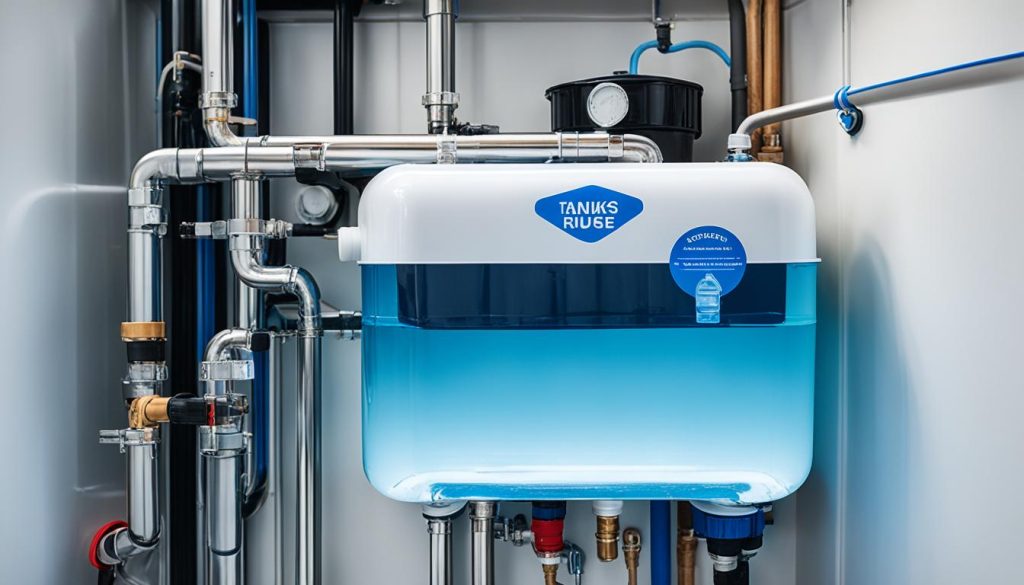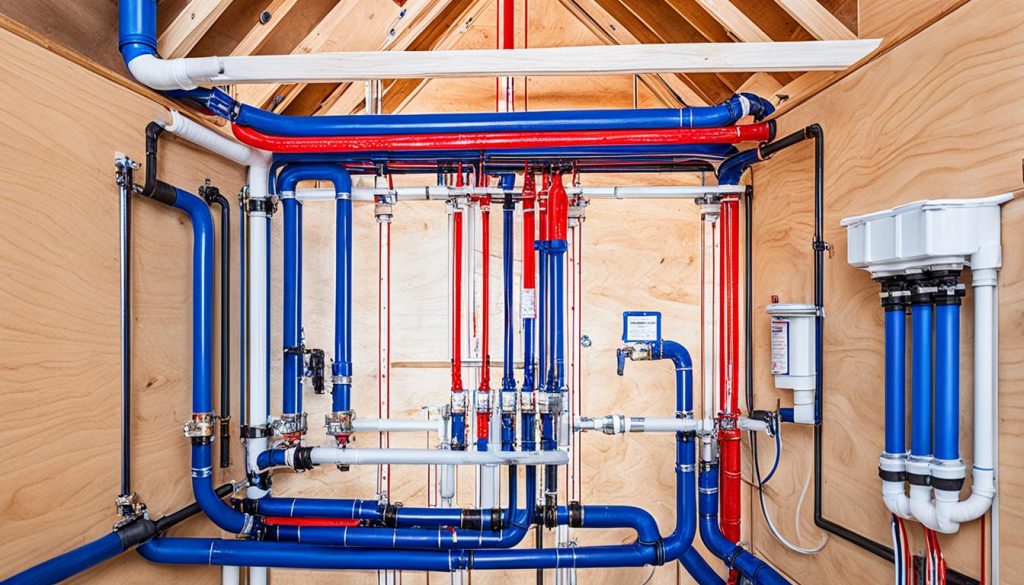Tiny House Plumbing Explained: How Does It Work?
Did you know that the average person uses around 100 gallons of water per day? Now imagine fitting an entire household’s water needs into a tiny house. Sounds challenging, right? Well, plumbing in a tiny house comes with its own set of unique considerations and solutions. From managing water supply to dealing with sewage, building a functional plumbing system in a compact space requires careful planning and innovative approaches. In this article, I will delve into the world of tiny house plumbing, exploring the differences between traditional and tiny house plumbing systems, water hook-up options, the role of water tanks, the benefits of PEX plumbing, and essential tips for a successful plumbing installation in a tiny house.
Key Takeaways:
- Plumbing in a tiny house requires unique solutions due to the limited space.
- Water hook-up options for tiny houses include on-grid and off-grid plumbing.
- Water tanks can provide self-sufficiency and mobility in a tiny house.
- PEX plumbing is a popular choice for its affordability and ease of installation.
- Tips for successful tiny house plumbing include efficient layout planning and regular maintenance.
Tiny House Water Hookups
When it comes to water hookups in a tiny house, there are two main options to consider: on-grid plumbing and off-grid plumbing. Each method has its own advantages and considerations.
On-Grid Plumbing
In on-grid plumbing, a tiny house is connected to a city water source using a water hose. This method is simple and convenient for those who have access to a water supply. It allows for consistent water flow and eliminates the need to manually refill water tanks.
On-grid plumbing is ideal for tiny house owners who plan to park their homes in locations with city water connections. It provides a reliable and constant water supply, making daily activities such as cooking, cleaning, and showering hassle-free.
When setting up on-grid plumbing, it’s essential to ensure that the water hose is properly connected to the tiny house and that there are no leaks or weak fittings. Regular maintenance and inspections are also necessary to prevent any issues with the water hookup.
Off-Grid Plumbing
If living off-grid or in a remote location where a direct water connection is not available, off-grid plumbing is a suitable solution. This method involves storing water in a tank inside the tiny house.
Off-grid plumbing provides independence and self-sustainability, allowing tiny house owners to live in remote areas without sacrificing basic amenities. It also eliminates the need for a continuous water supply and reduces dependence on external resources.
When opting for off-grid plumbing, it’s crucial to consider factors such as water availability, tank capacity, and maintenance. Regularly monitoring and refilling the water tank is necessary to ensure an adequate supply. It’s also important to insulate the tank and plumbing system to prevent freezing during colder months.
In summary, whether you choose on-grid plumbing with a water hose or off-grid plumbing with a water tank, it’s important to weigh the pros and cons based on your specific needs, location, and water availability. Both methods offer their advantages and considerations, and the decision ultimately comes down to your preference and circumstances.
Comparison of On-Grid and Off-Grid Plumbing
| Aspect | On-Grid Plumbing | Off-Grid Plumbing |
|---|---|---|
| Water Source | City water supply | Water tank |
| Convenience | Simple and hassle-free | Requires regular maintenance |
| Water Availability | Dependent on city water supply | Dependent on tank capacity and refilling |
| Mobility | May limit mobility depending on water hookup availability | Offers flexibility and independence |
| Sustainability | Relies on external water source | Self-sufficient and sustainable |
Tiny House Water Tanks
Many tiny house owners choose to use water tanks to make their homes more self-sufficient and to have a water source while traveling. Having a reliable water storage system is essential, especially for those living off-grid or in remote locations where access to a direct water connection is limited.
The size of the water tank you choose depends on your water consumption needs and the duration you plan to rely on the tank. While the average person uses around 100 gallons of water per day, water consumption can be significantly reduced in a tiny house due to the smaller living space and mindful water usage habits.
When installing a water tank in a tiny house, it’s crucial to consider weight distribution and balance. Too much weight on one side of the house can be dangerous and affect mobility. Careful planning and consultation with an engineer or professional are recommended to ensure the safe installation of the tank.
Choosing the Right Tank Capacity
The tank capacity you select should align with your specific water consumption needs and lifestyle. Consider factors such as the number of occupants, daily water usage, frequency of tank refills or recharges, and any additional water needs for activities like gardening or washing clothes.
Here’s a general guideline for estimating tank capacity based on the number of occupants:
| Number of Occupants | Estimated Tank Capacity (gallons) |
|---|---|
| 1-2 | 20-50 |
| 3-4 | 50-80 |
| 5+ | 80+ |
Keep in mind that these estimates may vary depending on individual water consumption habits and the duration of time you plan to rely on the tank between refills or recharges.
Connecting the Water Tank
Water tanks in tiny houses need to be connected to a pump system for efficient water distribution. The pump system ensures that water is delivered to different fixtures in the tiny house like sinks, showers, and toilets.
It is essential to install a reliable and properly sized pump that can meet the required water pressure for the fixtures. Consult a professional plumber or water system expert to ensure the pump system is suitable for the tank capacity and water demands of your tiny house.
Regular maintenance of the water tank and pump system is necessary to ensure their proper functioning and longevity. Inspecting for leaks, checking the water level, and maintaining filters and valves are among the routine tasks to keep the water system in optimal condition.
In the next section, I will discuss the advantages of using PEX (Cross-Linked Polyethylene) plumbing in a tiny house, including its ease of installation and durability.
PEX Plumbing Makes Tiny House Plumbing Easy
In the world of tiny house plumbing, PEX (Cross-Linked Polyethylene) is a game-changer. Its affordability, durability, and ease of installation make it the go-to choice for many tiny house owners. Let’s explore the advantages of PEX, different PEX tubing sizes, PEX fittings, and the recommended bending radius for PEX tubing.
The Advantages of PEX Plumbing
PEX plumbing offers several key advantages for tiny houses:
- Affordability: PEX tubing is cost-effective, making it ideal for budget-conscious tiny house builders.
- Durability: PEX is resistant to corrosion, scale, and freeze damage, ensuring a long-lasting plumbing system.
- Easy Installation: PEX tubing is flexible and can be easily maneuvered around tight corners, simplifying the plumbing process.
PEX Tubing Sizes and Color Coding
PEX tubing comes in various sizes to accommodate different flow rates and water pressure requirements:
| PEX Tubing Size | Recommended Use |
|---|---|
| 3/8 inch | Low flow fixtures such as faucets and toilets |
| 1/2 inch | Most common size for residential plumbing |
| 3/4 inch | High flow fixtures such as showers and washing machines |
To differentiate hot and cold water lines, PEX tubing can be color-coded. Red is typically used for hot water lines, while blue is used for cold water lines. This simple visual distinction helps ensure a properly functioning plumbing system.
PEX Fittings for Easy Connections
Connecting and disconnecting PEX tubing is effortless thanks to PEX fittings. One popular type of PEX fitting is the push connector or “Shark Bite.” These fittings allow for quick and secure connections without the need for glue or specialized tools. They are perfect for DIYers or anyone looking for a hassle-free plumbing experience.
Recommended Bending Radius for PEX Tubing
While PEX tubing is flexible, it is important to adhere to the recommended bending radius to prevent kinking or damaging the tubing. The bending radius depends on the PEX tubing size:
| PEX Tubing Size | Recommended Bending Radius |
|---|---|
| 3/8 inch | 5 inches |
| 1/2 inch | 6 inches |
| 3/4 inch | 8 inches |
Following the recommended bending radius ensures smooth water flow and minimizes the risk of leaks or blockages in the system.
Tips for Plumbing a Tiny House
When plumbing a small living space like a tiny house, there are a few tips that can help you optimize space and create a compact plumbing setup. Here are some key considerations to keep in mind:
1. Plan the layout: Carefully plan the layout of your plumbing system to maximize space and minimize the length of water lines. This will not only help you save space but also make maintenance and repairs easier in the long run.
2. Choose compact fixtures: Look for compact and space-saving fixtures specifically designed for small living spaces. There are various options available, including slimline toilets, corner sinks, and space-saving tankless water heaters.
3. Insulate pipes for winter: Insulating your plumbing pipes is crucial, especially during the cold winter months. Proper insulation helps prevent freezing and bursting of pipes, which can cause serious damage. Consider using foam pipe insulation or heat tape to protect your pipes from freezing temperatures.
4. Install a water pressure gauge: To ensure the proper functioning of your plumbing system, it’s a good idea to install a water pressure gauge. This device will help you monitor the water pressure and detect any potential issues early on.
5. Regular maintenance is key: Make a habit of regularly checking for leaks and maintaining proper insulation throughout your tiny house. This will help you catch any plumbing problems early and ensure that your system remains efficient and long-lasting.
By following these tips, you can create an efficient and reliable plumbing system in your tiny house, optimizing the available space while ensuring year-round functionality and comfort.
- Investing Wisely: How Windows & Doors in Boost Property Value and Financial Health - April 24, 2025
- The Financial Impact of Personal Injuries: Why Legal Help Matters for Business Owners - April 16, 2025
- The Hidden Financial Costs of Domestic Assault: What Business Owners Need to Know - April 16, 2025













